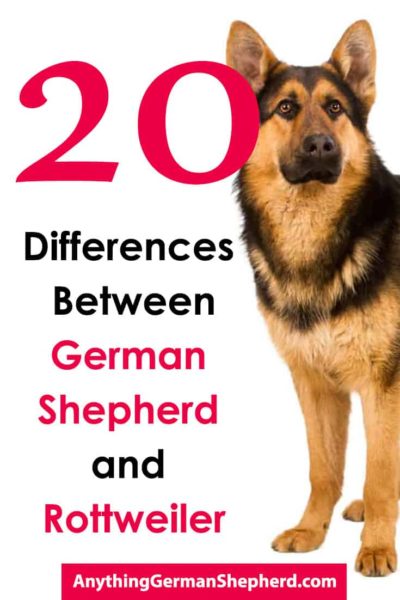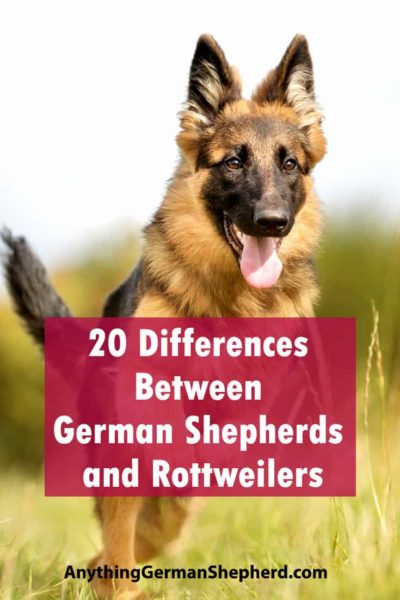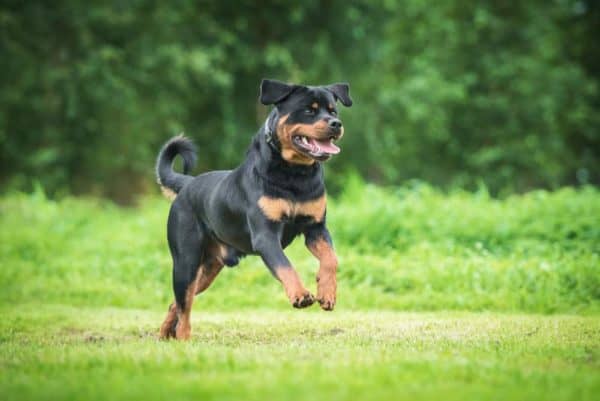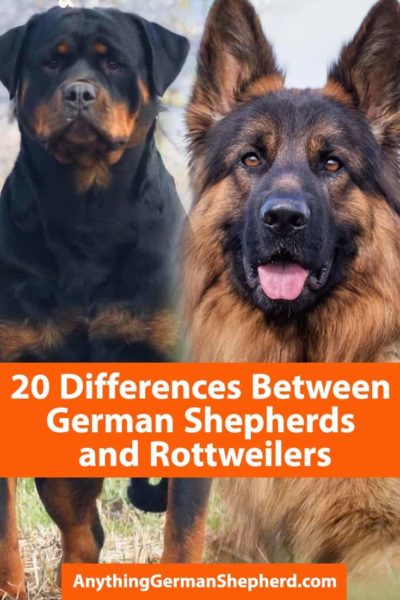German Shepherd vs Rottweiler: 20 Differences You Should Know
At first glance, there are a lot of similarities between German shepherd dogs (often called GSDs) and Rottweilers (or Rotties.)
They’re similar in size, similar in looking tough, both are black and tan (mostly) and both share an undeserved reputation for aggressiveness toward people.
Once you really take the time to compare the two breeds, you find that there are many glaring differences between them.
These include the shape of the head, the shape of the ears, backbone shape, country of origin, and how popular they are. GSDs are also more prone to some health problems.
Keep in mind that this article describes the differences in the average GSD and the average Rottie. Of course, all dogs have individual quirks and may not fit the average.
Read on to find out all the striking differences.
One: Differences in Popularity
Have a black and tan mixed breed dog that shared physical characteristics of both GSDs and Rotties?
The chances are much higher that your dog has GSD in him than Rottweiler. According to the American Kennel Club (or the AKC), GSDs are the second most popular dog breed in America.
In contrast, Rottweilers are only the eighth most popular breed, as of 2018. Although the breed is gaining in popularity, it still has a bad image problem to overcome.
Back in the 1990s, the Rottie was the second most popular dog breed – the position the GSD holds today.
GSDs were accepted into the AKC way back in 1908. The Rottie was accepted much later in the 1930s.
German shepherds are more familiar to Americans and therefore have become more desired to own.
Two: Differences in Popular Culture
The most influential and arguably best movie dog of all time was a German-born GSD named Rin Tin Tin.
Since he first appeared in his first movie in 1923, GSDs have become a familiar furry face on the large and small screens, in comic books, and in advertising.
In contrast, Rottweilers rarely play a starring role in films or television shows. When seen, he usually is attacking the hero.
A child-friendly Rottie was featured in the Robert De Niro movie The Fan (1996) but that is about the only popular movie where Rotties are seen as being good.
Are GSDs in movies more because they are easier to train? Not at all.
With their triangular-shaped ears, GSDs can play not only dogs but wolves and at least one pack of long-suffering GSDs played giant man-eating shrews in The Killer Shrews (1959).

Three: Differences in Ear Shape
GSDs sports ears shaped like triangles. Occasionally a purebred will have one or both floppy ears, but these individuals are never shown and rarely bred.
In contrast, Rotties’ ears are floppy. Some cruel Rottie owners crop their dogs’ ears into triangles to make them look tougher.
There is a time when both GSDs and Rotties have floppy ears. Puppies of all breeds are born with floppy ears.
GSD ears begin sticking up anywhere from two to eight months of age, according to the book Your German Shepherd Puppy Month By Month (2012.)
Sometimes GSD puppy ears do not stand up on their own. Breeders and anxious owners often tape the ears to help train the ears to stay up.
However, a good pet dog does not have a specific ear shape.
Four: Differences in Head Shapes
People new to the world of dogs often think GSD and Rottie heads are shaped the same. You get to know enough dogs and you quickly see the many differences between the heads of the two breeds.
German shepherd dogs sport longer noses than do Rottweilers. When looking at the dogs’ head in profile, you see right away that the Rottie nose is much blunter.
It’s not as short as a Boxer’s but is midway in the length between a GSD and a Boxer.
Let’s pretend that a GSD and a Rottie are standing next to each other. Look at the dogs from head-on (pun intended.)
You’ll see right away that the GSD has a narrower head than the Rottie.
Five: Differences in Bite Power
There’s a big consequence of the Rottweiler having a shorter nose and broader head than the GSD. Rottie bites are much more powerful than a GSD.
This strong bite is why Rotties are so often used as guard and protection dogs.
This powerful bite, and ability to inflict more damage, gave the Rottie a reputation for viciousness in the 1980s.
Just as pit bulls are maligned in popular media today, so Rotties were back then.
Rotties descend from war dogs bred to have strong bites for battles, but the modern Rottie is a sweetheart.
All dogs can bite, no matter what their size or breed.
According to Forbes magazine, the pit bulls are the breed most prone to biting, with Rotties in second place and GSDs in third.
It’s important to train any dog not to bite, even when playing because dogs do not know their own strength.

Six: Differences in Backbone Shape
It’s hard to compare the toplines or backbone shapes of dogs when they are moving about. When they are standing still you can easily tell the difference in the two breeds.
Even websites such as Wikipedia will show dog breeds in a profile where you can compare the toplines.
In profile, a GSD’s backbone slopes down sharply from the shoulders to the tail. This makes the dog look like it’s about to spring into action.
GSDs were bred this way to make them resemble stalking wolves to impress the sheep they were bred to control.
Now, look at the Rotties on Wikipedia. Their backbones slope down slightly from shoulders to tail, but nowhere near as extreme as with GSDs.
Their toplines are much more level than that of a German shepherd.
Seven: Differences in Country of Origin
According to Anything Rottweiler, Rottweilers originated around the German town of (you guessed it) Rottweil (pronounced ROT VILE).
They are thought to be descendants of a breed of war and herding dog brought to Germany by the Roman army way back in 74 AD.
So, with a name like the German shepherd, that breed must originate in Germany, too, right? Wrong!
Only a few countries like America call this dog the German shepherd. Most of the world calls it by its proper name, the Alsatian.
Alsace has historically been a highly coveted area. Over the centuries, it has been taken over by the French and then the Germans.
Since the end of World War II in 1945, Alsace has been inside French borders.
Eight: Differences in Why the Breed Was Developed
As their American popular name suggests, German Shepherds were originally bred to round up and protect livestock, especially sheep.
It can be hard to remember their origins when they are so frequently seen as police dogs, rescue dogs, and guides for the blind.
Rottweilers were also bred to herd and protect livestock, but they also had an added benefit. Because they were so strong, they could pull small carts.
It was cheaper and easier for German butchers to keep a dog rather than a horse, so their dogs pulled meat to market.
This has given the Rottweilers a popular name in Germany: butcher dogs.
This just means that butchers were most likely to keep the dog and does not refer to the dogs doing any actual butchering.

Nine: Differences in Color
Rottweilers are always black and tan. Sometimes the amount of black and tan differs from dog to dog, but the predominant colors are black and tan.
Very rarely, white spots, most often on the chest, pop up in purebred Rottie puppies.
Since the most common color of a German Shepherd is black and tan, at first there may not be much of a color difference between a particular GSD and a Rottie.
However, GSDs come in many different colors than Rotties, including the highly controversial pure white.
Other colors include all black, all dark brown (called liver) black and red, dark brown and tan, black and silver, blue and tan, sable, isabella, and a mix of black, tan, and white (called panda.)
Ten: Differences in Tails
If you are an American or Canadian, then you’re probably wondering why dog tails have not been mentioned yet.
They’re a pretty obvious difference. Rottweilers do not have tails while German shepherds do.
Actually, both breeds are born with tails. It has been popular to dock or remove the tails of Rottweiler puppies to make them win at shows and to be fashionable.
Fortunately, many countries like the United Kingdom and Australia ban tail docking for purely cosmetic reasons.
Not all American or Canadian Rottie owners dock their dog’s tails. Rottie tails are similar to German shepherd tails in length and shape but do not have as much hair.
Eleven: Differences in Getting Into Fights With Other Dogs
Those docked tails may win ribbons and trophies at dog shows, but they come at a great cost. Rottweilers with docked tails are far more likely to get into fights with other dogs than will GSDs.
This is not because docked Rottweilers are more prone to fighting other dogs. This is because they lack tails.
Tail positions and movements are two of the major ways that dogs have of communicating with each other.
Without their tails, Rotties have a hard time communicating with other dogs. It’s as if you had your voice taken away.
This leads to many canine communication breakdowns, quarrels, and fights.

Twelve: Differences in Coat Length
German shepherds look a lot fluffier than Rottweilers. Why is this? GSDs have longer hair than a Rottie and have weather-resistant double coats.
Rottweiler coats are smooth and shiny, covered with short hairs. This does make the Rottweiler prone to shedding more than the GSD.
Daily brushing helps handle stray hairs from scattering everywhere.
German shepherds were bred to have thick coats in order to protect them from the weather, especially cold weather.
They needed to be outdoors 24/7 in order to protect flocks and herds. Their undercoats are short and thick while the outercoats sport long, harsher hairs.
Thirteen: Differences in Life Spans
The saddest difference between German shepherds and Rottweilers is the length of their expected lifespans. On average, Rotties only average ten years of life, while GSDs average thirteen years.
Just why this happens is not entirely clear.
According to JSTOR Studies, such as this one published in 2013 in The American Naturalist have shown that the larger the dog, the shorter the lifespan.
This is why the world’s oldest dogs tend to be small like miniature dachshunds or Australian cattle dogs.
It’s thought that larger dogs die sooner because they age faster. However, most GSDs and Rotties are the same height.
Larger here does not mean which dog is taller, but which dog has a larger overall body mass.
Fourteen: Differences in Size
As previously mentioned, German shepherds and Rotties are similar in height. Males of both breeds tend to be bigger and heavier than the females.
GSDs grow anywhere from 22 to 26 inches high from the ground to the tops of their withers (or highest point of the shoulder.)
GSDs are sleeker and lighter than Rotties. On average, a GSD weighs from 49 pounds of a small female to 88 pounds for a large, healthy male.
Rotties are usually heavier than GSDs. The weight is the muscle and not fat (or shouldn’t be fat, anyway.)
Rotties tip the scales anywhere from 77 to 130 pounds. Yes, they are big-boned.

Fifteen: Differences in Susceptibility for Degenerative Myelopathy
German shepherds are special dogs. They’d have to be in order to be the second most popular dog breed in America.
Unfortunately, they are so special that they have their own disease that no other dog breed gets.
This incurable disease is called degenerative myelopathy (or ME for short). It’s basically a canine form of multiple sclerosis.
According to MAGSR, It appears in older GSDs, with the youngest victims being seven years old, notes the Mid-Atlantic German Shepherd Rescue.
Just why German shepherds suffer from ME and not other dog breeds, even heavier and stockier breeds like the Rottie, is unknown.
Milder but still serious forms of ME appear very rarely in other breeds like the Old English Sheepdog.
Sixteen: Differences in Susceptibility for Pannus
Pannus is one of the common names for a nasty eye condition called chronic superficial keratitis.
Symptoms include a pink growth on the cornea, lesions on the cornea, and a thickening of the inner eyelid. Eventually, if not treated, the dog goes blind.
The cause of pannus is unknown, but genetics are thought to be a leading factor.
The other common name for pannus is German shepherd keratitis, which lets you know what breed loses the genetic roll of the dice here. However, the disease does impact Belgian Tervurens.
The disease does pop up in other breeds like border collies and Belgian shepherds, but very rarely. It’s not out of the question that a Rottie may one day get it.
Until then, the most common dog to get this is a GSD that is at least four years old.
Seventeen: Differences in Susceptibility for Pancreatic Enzyme Insufficiency
This is yet another medical condition that German Shepherds are prone to far more than any other dog breed, including Rottweilers.
The bad news is that this condition is incurable. The good news is that it is treatable, although it is expensive to treat.
The problem is that the pancreas has problems absorbing all the chemicals it is supposed to absorb. This causes major problems like diarrhea, vomiting, loss of appetite, and severe abdominal pain.
Contact your vet right away if your GSD experiences any of these symptoms.
Why are German shepherds more prone to certain health problems than other dog breeds?
This is unknown, but one theory is that demand for GSDs leads to rampant inbreeding by unscrupulous GSD breeders.
The GSD is sometimes the victim of its own success.

Eighteen: Differences in Training Techniques
Rotties are more food-obsessed than German shepherds. What does this mean?
This means if you are trying to teach your Rottie to do something, make sure you reward him or her with food.
GSDs have healthy appetites, too and so food rewards can help in positive training techniques like clicker training.
However, what happens when a GSD’s stomach is full? Training can continue with a favorite toy as a reward or a walk.
Keep in mind that all dogs are individuals. Although generally, Rottweilers love food more than just about anything, not all Rotties will roll over for treats.
Study your dog and get to know what really gets him or her excited enough to use as a training reward.
Nineteen: Differences in Being Prone to Weight Gain
Because Rottweilers love their food so much, they are in danger of getting and staying overweight faster than German shepherds.
Overweight dogs are more prone to health problems like heart disease and arthritis. Get your Rottie weighed at least once a year to check the weight.
Love to train your Rottie using food rewards? You’re Rottie loves it, too, but too much.
Use lower-calorie treats such as fresh broccoli, baby carrots, or smaller pieces of your usual treat.
It’s not the amount of food that rewards the dog, but that he or she is getting a treat in the first place.
Another tip is that you do not have to reward your Rottie with food every single time the desired behavior is performed, like a sit.
Alternate food rewards with affection and verbal praise. Some Rotties will be just as motivated for affection as for food.
Related Post: 7 Best Food For German Shepherd To Gain Weight
Twenty: Differences in Being Targeted By Dog Thieves
Unfortunately, some people see pet dogs as nothing more than a means for some quick cash. The most stolen breed is the tiny Yorkshire Terrier, followed by the Maltese.
The German shepherd is the ninth most popular stolen breed, according to the IHeartDogs.
GSDs are stolen for many reasons to make the thief money. The most common reason is being used as a bait dog to train illegal fighting dogs.
GSDs are large enough to put up a fight but weak enough to succumb to a pit bull or other dog forced to fight.
Rottweilers are not stolen as often, perhaps because Rotties are much heavier than most breeds. If they don’t want to move, they’re not going anywhere.
Still, Rottie owners should always be alert for thieves.
In Summary
Both German shepherds and Rottweilers are popular dog breeds. They stand about the same height and are mainly black and tan.
Both are intelligent, lively breeds that make devoted companions and co-workers in jobs like herding livestock or serving in the Army.
However, for all of their similarities. these two breeds contain a world of differences.
They differ in their physical appearance, history, temperament, and susceptibility to getting certain diseases or other medical problems.
Before bringing either a Rottweiler or German shepherd into your life, do your homework. Get to know the best and the worst that could happen with these breeds.
Enjoy the quirks your individual dog has, even if he or she does the unexpected for his or her breed.
Related Post: Can a GSD Rottweiler Mix Be the Best Dog For Your Family?
FAQ:
1. What are the main differences between German shepherd dogs and Rottweilers?
Answer: While they may be similar in size, appearance, and undeserved reputation for aggression, there are many glaring differences between German shepherd dogs and Rottweilers, including differences in head shape, ear shape, backbone shape, country of origin, popularity, and color. German shepherds are also more prone to some health problems.
2. Why are German shepherds more popular than Rottweilers?
Answer: According to the American Kennel Club, German shepherds are the second most popular dog breed in America, while Rottweilers are only the eighth most popular breed, as of 2018. German shepherds are more familiar to Americans and therefore have become more desired to own.
3. Why are German shepherds more frequently seen in movies and popular culture than Rottweilers?
Answer: German shepherds have become a familiar furry face on the large and small screens, in comic books, and in advertising, partly due to the influence of Rin Tin Tin, a German-born GSD who became the most influential and arguably best movie dog of all time. In contrast, Rottweilers rarely play a starring role in films or television shows.
4. What are the differences in ear shape between German shepherds and Rottweilers?
Answer: German shepherd dogs have ears shaped like triangles, while Rottweilers’ ears are floppy. GSDs occasionally have one or both floppy ears, but these individuals are never shown and rarely bred. Some cruel Rottie owners crop their dogs’ ears into































